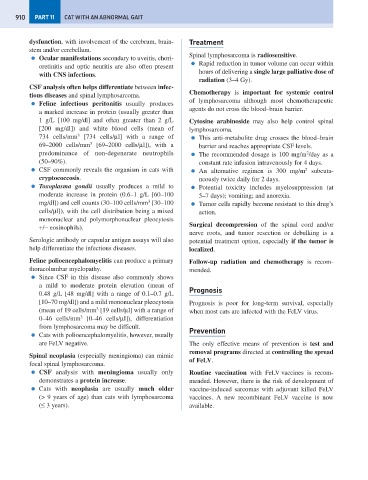Page 918 - Problem-Based Feline Medicine
P. 918
910 PART 11 CAT WITH AN ABNORMAL GAIT
dysfunction, with involvement of the cerebrum, brain- Treatment
stem and/or cerebellum.
Spinal lymphosarcoma is radiosensitive.
● Ocular manifestations secondary to uveitis, chori-
● Rapid reduction in tumor volume can occur within
oretinitis and optic neuritis are also often present
hours of delivering a single large palliative dose of
with CNS infections.
radiation (3–4 Gy).
CSF analysis often helps differentiate between infec-
Chemotherapy is important for systemic control
tious diseases and spinal lymphosarcoma.
of lymphosarcoma although most chemotherapeutic
● Feline infectious peritonitis usually produces
agents do not cross the blood–brain barrier.
a marked increase in protein (usually greater than
1 g/L [100 mg/dl] and often greater than 2 g/L Cytosine arabinoside may also help control spinal
[200 mg/dl]) and white blood cells (mean of lymphosarcoma.
3
734 cells/mm [734 cells/μl] with a range of ● This anti-metabolite drug crosses the blood–brain
3
69–2000 cells/mm [69–2000 cells/μl]), with a barrier and reaches appropriate CSF levels.
predominance of non-degenerate neutrophils ● The recommended dosage is 100 mg/m /day as a
2
(50–90%). constant rate infusion intravenously for 4 days.
● CSF commonly reveals the organism in cats with ● An alternative regimen is 300 mg/m subcuta-
2
cryptococcosis. neously twice daily for 2 days.
● Toxoplasma gondii usually produces a mild to ● Potential toxicity includes myelosuppression (at
moderate increase in protein (0.6–1 g/L [60–100 5–7 days); vomiting; and anorexia.
3
mg/dl]) and cell counts (30–100 cells/mm [30–100 ● Tumor cells rapidly become resistant to this drug’s
cells/μl]), with the cell distribution being a mixed action.
mononuclear and polymorphonuclear pleocytosis
Surgical decompression of the spinal cord and/or
+/− eosinophils).
nerve roots, and tumor resection or debulking is a
Serologic antibody or capsular antigen assays will also potential treatment option, especially if the tumor is
help differentiate the infectious diseases. localized.
Feline polioencephalomyelitis can produce a primary Follow-up radiation and chemotherapy is recom-
thoracolumbar myelopathy. mended.
● Since CSF in this disease also commonly shows
a mild to moderate protein elevation (mean of
Prognosis
0.48 g/L [48 mg/dl] with a range of 0.1–0.7 g/L
[10–70 mg/dl]) and a mild mononuclear pleocytosis Prognosis is poor for long-term survival, especially
3
(mean of 19 cells/mm [19 cells/μl] with a range of when most cats are infected with the FeLV virus.
3
0–46 cells/mm [0–46 cells/μl]), differentiation
from lymphosarcoma may be difficult.
Prevention
● Cats with polioencephalomyelitis, however, usually
are FeLV negative. The only effective means of prevention is test and
removal programs directed at controlling the spread
Spinal neoplasia (especially meningioma) can mimic
of FeLV.
focal spinal lymphosarcoma.
● CSF analysis with meningioma usually only Routine vaccination with FeLV vaccines is recom-
demonstrates a protein increase. mended. However, there is the risk of development of
● Cats with neoplasia are usually much older vaccine-induced sarcomas with adjuvant killed FeLV
(> 9 years of age) than cats with lymphosarcoma vaccines. A new recombinant FeLV vaccine is now
(≤ 3 years). available.

